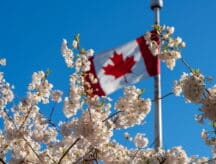Why does Quebec have its own immigration policy?
With its own set of selection criteria, distinct programs, and the ability to select its skilled workers from abroad— Quebec today holds more power than any other province in terms of its ability to influence its immigration.
In 1995 the Francophone province almost voted to become an independent state within Canada; with a modest 0.58% of votes as the deciding force to stay in the Canadian Dominion. It is important to note that the drivers that shaped the call for the 1995 referendum are the same ones that led Quebec to the power it holds over immigration today—forces deeply rooted in the province's history and culture.
Discover if You Are Eligible for Canadian Immigration
A Unique Creation
Quebec has a distinct historical and cultural background, older than that of English Canada. In 1608, (over 250 years before the Confederation of Canadian Dominion) the French diplomat and explorer Samuel de Champlain established the city of Quebec with his 28 men— claiming the province as a part of New France (a French territory spanning much of the east coast of Canada and the United States).
He did so on the abandoned Iroquoian settlement called Stadacona; with Iroquoian tribes directing him to the site using their native word for village “kanata”—it is here that the name Canada originates.
De Champlain—widely regarded as the father of New France—would remain the administrator of New France until his death in 1635. In 1763, following the conclusion of the Seven Years’ War, France would sign the Treaty of Paris, ceding the territories of New France (including Quebec) to the British—this friction would help set the stage for the emphasis on Francophone culture that is seen today.
Quebec was already different historically, culturally, and demographically from the rest of Canada (which the British colonized to profound effect). Quebec would serve as the capital of the English Province of Canada (today divided into Quebec and Ontario) twice, before becoming integrated into the wider Dominion of Canada in 1867.
However, the integration of Quebec into the Canadian dominion was never as complete as with English Canada; with the Quebecois retaining much of the language, customs, legal frameworks, and religion brought over by the French.
The 1960s were a time of intense and rapid changes in Quebec, known widely as the “quiet revolution”. In 1961 Quebec sought to establish democratic ties with France, the UK, and the United States –however, the federal government intervened—asserting there could only be “one interlocutor” with foreign countries.
The event would ignite debate about the place of Quebec and French Canadians in the Confederation. In 1968 these cultural forces, along with a change in Canada’s immigration policy (moving from a tiered system by country of origin, to a points-based system grounded in individual applicant’s work skills, language ability, family connections, and education) led to the creation of Quebec’s first immigration ministry.
1971 – 1991: The Negotiation for Immigration
According to the Constitution Act of 1867, immigration holds a special place among powers, being controlled at both the federal and provincial levels – however, today no province holds as much sway over its immigration as Quebec does.
The creation of Quebec’s immigration ministry signaled Quebec’s assertion that controlling immigration to the province was a key issue—not just for economic reasons, but also, to preserve the French language and Francophone culture as a primary concern. As a result, Quebec would recruit Francophones from around the world during this period.
Between the years 1971 and 1991, Quebec would continually renegotiate its provincial authority over immigration; resulting in four major pieces of legislation that would shape the province’s powers:
- 1971’s Lang-Cloutier agreement was the first piece of Canada-Quebec immigration legislation; the agreement allowed Quebec to have representatives in Canadian embassies, and for immigration counseling abroad, largely heralding administrative changes to Quebec’s role in Canadian immigration;
- 1975’s Andras-Bienvenue agreement gave Quebec a part in the process of selecting immigrants, allowing the province to conduct interviews and make recommendations to visa officers. This was a huge milestone for the province, as the legislation enshrined in law meant that the federal government would now have to consider Quebec’s opinion for every new immigration application to the territory;
- 1978’s Cullen-Couture agreement extended the same rights to temporary immigration, defining its selection criteria, and giving the province even more sway over immigration to its borders; and finally,
- 1991’s Gagnon-Tremblay-McDougall agreement—also known as the Quebec-Canada Accord—represented the biggest triumph for Quebec immigration in the province’s history. Under this legislation, the province gained full selection process of immigrants (especially economic immigrants) to its borders; as well as the integration and francization of these individuals in the province.
From the Past to the Future
A quick historical summary of Quebec’s immigration policy evidences that one of the province’s primary concerns is the preservation and promotion of Francophone culture and the French language.
In 1977 Bill 101 (The Charter for the French Language) was instated. A huge political milestone in the Quebecois landscape, this piece of legislation made it so that French became the everyday language of Quebec. Most immigrant children (for example) would now attend French-speaking schools above English-speaking ones.
In June of 2022, this Charter was updated with Bill 96 – extending further the emphasis on French in Quebec. Today French is the exclusive language of communication between the Quebec government and its residents. In addition, communication between businesses and their clients and customers, labelling of products, and contracts with Quebec’s civil administration are to be exclusively in French.
Why does this matter to you?
Understanding why Quebec’s immigration policy differs from the rest of Canada is a key step for any wanting to immigrate to the province. With Quebec’s emphasis on French and Francophone culture, immigrants who hail from similar backgrounds may see greater success in trying to immigrate, settle, and live in the province as opposed to other ones in Canada—especially if they can meet the economic criteria laid out by the Quebec government as well.
Discover if You Are Eligible for Canadian Immigration
© CIC News All Rights Reserved. Visit CanadaVisa.com to discover your Canadian immigration options.
- Do you need Canadian immigration assistance? Contact the Contact Cohen Immigration Law firm by completing our form
- Send us your feedback or your non-legal assistance questions by emailing us at media@canadavisa.com







